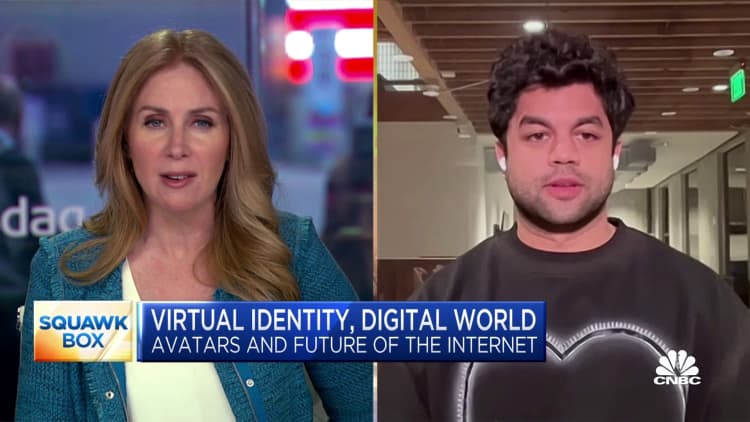HAIAN, CHINA – NOVEMBER 7, 2023 – A crab farmer sells crabs via a live webcast at Xinhai village in Haian city, Jiangsu province, China, Nov 7, 2023. (Photo by Costfoto/NurPhoto via Getty Images)
Nurphoto | Nurphoto | Getty Images
BEIJING — Livestream shopping is taking off in China, driving development of new tech products such as virtual human streamers and mobile data packages.
It’s an attempt to monetize — and innovate — in one of the few bright spots for an economy that’s largely slowing in growth.
Livestreaming e-commerce saw sales surge by 19% during the latest Singles Day shopping festival in November, while sales via traditional e-commerce dropped by 1%, according to McKinsey analysis.
Since the onset of the Covid-19 pandemic in early 2020, retailers in China have rushed to hire or develop in-house livestream hosts to sell products. Individuals, such as online influencer Austin Li, have become celebrities and overnight millionaires through using livestream commerce.
“Livestreaming, particularly livestreaming commerce, is something no country in the world has anything at the scale China has,” said Daniel Zipser, senior partner and leader of McKinsey’s Asia consumer and retail practice.
Now companies are testing out livestreaming hosts that are digitally created humans — either avatars that represent an actual human host, or a virtual human being created from scratch.
That use of virtual livestreaming hosts was a trend that stood out during this year’s Singles Day, said Xiaofeng Wang, principal analyst at Forrester.
“The quality has improved a lot this year, the virtual hosts look more real, at least the ones I’ve seen from Tencent, JD,” she said.
Wang added that using virtual livestreamers is a way for retailers to differentiate themselves from others, as well as reduce the cost of hiring a famous influencer, who might also carry the risk of being involved with celebrity scandals.
Livestreaming, particularly livestreaming commerce, is something no country in the world has anything at the scale China has.
Daniel Zipser
senior partner, McKinsey
Tencent has launched a product that only needs a three-minute video of a user along with 100 spoken sentences to build a virtual avatar.
The company also has a “Zen Video” platform that lets people create simple promotional videos with a virtual human spokesperson.
Some companies are also combining ChatGPT-like artificial intelligence with livestreaming.
Online retail giant JD.com said its Yanxi virtual anchor product — based on the company’s AI model — was used in livestreaming sessions for more than 4,000 brands during Singles Day this year. One virtual streamer broadcast for 28 hours straight, according to JD’s technology arm.
Baidu, best known for its search engine and Ernie AI chatbot, got into online shopping this Singles Day with the first at-scale use of its virtual human livestreaming product “Huiboxing” on its “Youxuan” e-commerce platform. The company claims virtual humans ran 17,000 streams from Oct. 20 to Nov. 11.

During that time, electronics giant Suning saw virtual human livestreaming contribute more than 3 million yuan ($420,000) in gross merchandise value on a single day, according to Baidu. GMV measures sales over time.
The digital human livestreamers are currently free for merchants to use on Baidu’s e-commerce platform and are based on the large language model behind Ernie bot, said Wu Chenxia, head of Huiboxing, adding the product uses big data to create multiple livestreaming scripts in an instant.
Regulators have their eye on the sector.
OpenAI’s ChatGPT isn’t officially accessible in China. Baidu’s Ernie bot wasn’t available for widespread use until late August when Beijing gave the green light.
A path to 3D livestreaming?
Livestreaming success is also dependent on consistent video connection.
Potential buyers are almost always watching on their mobile phones, while sellers may try to livestream from the field where they are growing the produce.
Mobile service operators China Unicom and China Mobile have started to sell data packages geared toward livestreamers in parts of the country.
These packages splice the network so that livestreamers get priority service, similar to how an express lane on a highway may only allow buses to use it to avoid traffic, said Joe Wang of Huawei’s ICT department.
All that is based on having widespread 5G connectivity, which allows livestreamers to broadcast outdoors or simultaneously on multiple platforms, he said.
Looking ahead, 5.5G will theoretically increase download speeds by 10 times compared to 5G, and upload speeds by two to three times, Wang said. He expects 5.5G will reach consumers as early as 2025, while AI’s development is letting businesses quickly turn 2D images into 3D ones.
That means, Wang said, that 3D livestreaming may be a reality in about two years.
Why livestreaming is ‘not a hype’
In the meantime, even companies such as Quantasing that sell adult education courses have jumped on the bandwagon by hosting livestreaming e-commerce – generating GMV of 13.3 million yuan in August.
CEO Matt Li said Quantasing holds more than 10 livestreaming sessions at once, and uses technology to decide what types of products and resources to dedicate to each one in order to generate the most revenue.

As fast as it’s grown, livestreaming is subject to China’s stringent regulation on content.
Analysts have also pointed out that livestreaming sales are often impulse buys, leading to many product returns.
From Jo Malone London to Chinese education company New Oriental, companies have turned to livestreaming sales as a way to stay connected with consumers in China and get them to spend money.
Importantly, businesses are shifting from using influencers, known as KOLs in China, to in-house livestreamers, McKinsey’s Zipser said.
“It is a clear indication [livestreaming] is not a hype, but it is something that companies are embracing and putting resources behind and the result of that is something that is here to stay,” he said.
Read the full article here

